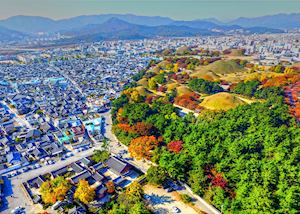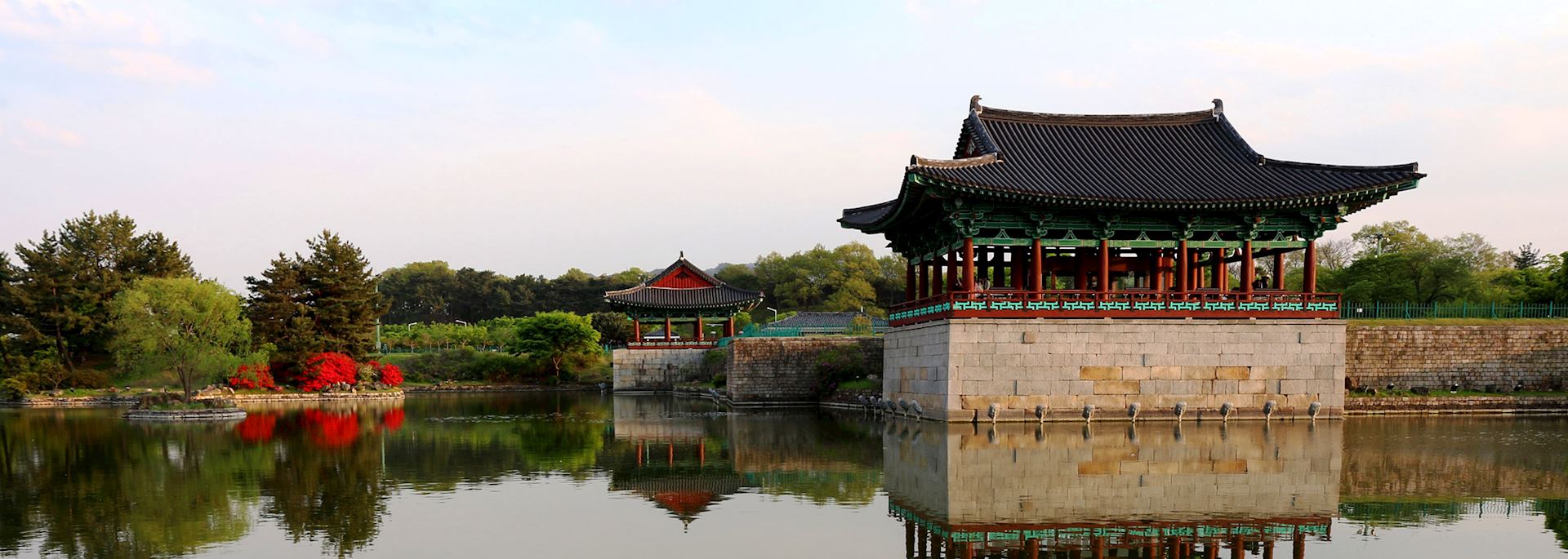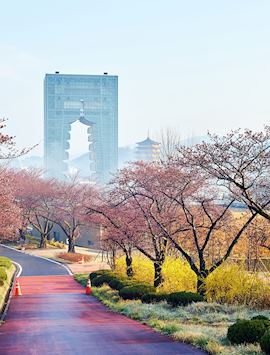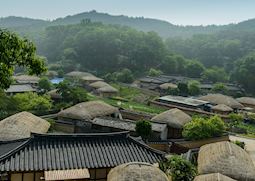Jump to:
Walk through streets lined with royal palaces, temples, tombs, pagodas and shrines in Gyeongju, the former capital of the Silla Dynasty (57 BC to 935 AD). Though this region of southeast Korea has been inhabited since prehistoric times, it’s best known as the home of the imperial capital for almost 1,000 years.
Despite the ravages of time and war, a considerable number of ancient structures remain, many of which have now been awarded UNESCO World Heritage status. Known as the ‘museum without walls’, it’s dense with ancient ruins and archaeological sites that you can explore. You’ll also find over 500 rounded grassy burial mounds that indicate the final resting place of the dynasty’s imperial rulers.
 One of the most impressive of the region’s sights is the Bulguksa, meaning Buddha World Temple, which lies southeast of the city. Built in 528, it was almost destroyed by the Japanese in 1593, so much of what you see today has been painstakingly reconstructed.
One of the most impressive of the region’s sights is the Bulguksa, meaning Buddha World Temple, which lies southeast of the city. Built in 528, it was almost destroyed by the Japanese in 1593, so much of what you see today has been painstakingly reconstructed.
The two white, stone staircases that lead to the entrance signify the path to Buddha and enlightenment and are so revered you cannot climb them. Inside the main courtyard stand two pagodas, one intricately decorated and the other plain. Behind them, you’ll find Daeungjeon, the brightly painted main hall that was reconstructed in 1765.
You can climb to another hall, Gwaneumjeon, at the top of the complex for an overview of the many buildings. If you’re feeling energetic, you can also climb the stone steps up the mountain ridge behind the temple complex to Seokguram, a Buddhist grotto.
The 2.2 km (1.4 mile) trail is steep but winds through dense forest and past a giant ceremonial bell to the ridge-top grotto. The grotto shelters a statue of Buddha surrounded by his guardians and was constructed in the 8th century. More impressive however, is the setting, with the views stretching as far as the Sea of Japan on a clear day.
 Twenty-three members of the Silla royal family are buried at the Tumuli Park, a walled series of grassy hillocks now surrounded by formal landscaping and walking paths. Known as tumuli, the mounds of rock and earth sit above a series of wood-lined burial chambers.
Twenty-three members of the Silla royal family are buried at the Tumuli Park, a walled series of grassy hillocks now surrounded by formal landscaping and walking paths. Known as tumuli, the mounds of rock and earth sit above a series of wood-lined burial chambers.
The only one of the tombs open to the public is the vast Cheonmachong, the ‘Heavenly Horse Tomb’, named after a birch-bark painting found here that depicts a Korean flying horse. The tomb is thought to have been built in the 5th or 6th century for an unknown Silla king. During excavation, the tomb was found to contain nearly 10,000 burial offerings including pottery, bracelets and crowns, most of which are now on display in the Gyeongju National Museum.
North of the city, the Yangdong Folk Village showcases traditional architecture against a backdrop of the four spines of Mount Seolchangsan. People still live in the village’s 160 houses, which represent the style of the Joseon Dynasty (1392 to 1910), with stone-walled lanes winding between thatched roofs to fields full of vegetables. This is Korea’s largest traditional village and offers a good impression of traditional living in rural Korea over the past 200 years.
Best time to visit Gyeongju
The best time to visit Gyeongju is between late March and May or October and November when the weather is warm and generally dry and you’ll see either the cherry blossom in bloom or vibrant autumnal foliage. June to August is hot and humid with highs of about 30°C (86°F) and increased rainfall, while December to March can see lows of -7°C (19°F).
who's been there
-
01993 838 92501993 838 756
- Make an enquiry
Suggested itinerary featuring Gyeongju
This sample itinerary will give you an idea of what is possible when you travel in Gyeongju, and showcases routes we know work particularly well. Treat this as inspiration, because your trip will be created uniquely by one of our specialists.
Places near Gyeongju
- Busan 48 miles away
- Seoul 172 miles away
- Jeju island 230 miles away
Photos of Gyeongju
Accommodation choices for Gyeongju
We've selected a range of accommodation options for when you visit Gyeongju. Our choices usually come recommended for their character, facilities and service or location. Our specialists always aim to suggest properties that match your preferences.
-
![Exterior]()
Hilton Gyeongju
Gyeongju
Ideas for experiencing Gyeongju
Our specialists seek out authentic ways to get to know the places that could feature in your trip. These activities reflect some of the experiences they've most enjoyed while visiting Gyeongju, and which use the best local guides.
-
Highlights of Gyeongju tour ![Yangdong folk village]()
Highlights of Gyeongju tour
Highlights of Gyeongju tour
The imperial capital for almost a millennium, Gyeongju is home to South Korea’s richest collection of historical buildings. Royal tombs and palaces, temples and pagodas dot the area and offer an insight into the enduring success of the Silla Dynasty.
View details




